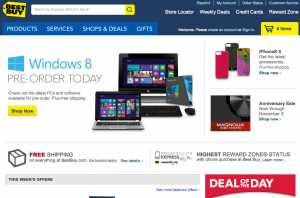According to a recent study by InsightExpress, 82% of consumers use a cellphone during their in-store shopping trips. Thanks to scanning apps, those with smartphones now have detailed product information, reviews and crucially, price comparison at their fingertips. The emergence of these apps is causing a major paradigm shift in brick and mortar retail, giving more power to consumers and presenting major challenges and opportunities for businesses. It’s also forcing retailers to think long and hard about how well their in-store experience is equipped to handle such an informed, savvy shopper. 
How Best Buy deals with Show-Rooming
Show-rooming, a phenomenon that has become a common problem for retailers in the last few years, refers to customers who are visiting a store in order to view and try out a product and then purchasing the item from an online retailer. This is particularly common with big ticket items, such as electronic goods, which can often be found much cheaper online than in-store.
Best Buy has attempted to combat this by displaying QR (Quick Response) codes on all of its in-store products. Once scanned, customers are taken to the product page on Best Buy’s mobile website, where they can access product specification, customer reviews and an online checkout. In many cases, the product may be significantly cheaper on the mobile site than the ticket price displayed in store, giving the customer a compelling reason to convert. By owning the online experience, as well as the physical one, Best Buy is ensuring that it captures and retains the customer and avoids losing them to a competitor.
How Macy’s drives cross-channel engagement
Macy’s ‘Backstage Pass’ campaign offers customers access to behind-the-scenes videos of celebrities such as Jessica Simpson and Martha Stewart, promoting their respective product lines. These are accessed by scanning QR codes on the iconic red stars on relevant products in its department stores. By taking customers to these videos, Macy’s is not only giving customers useful and engaging content, it is also diverting them away from online price comparison.
How Target is coping with the holiday rush
Target has recently rolled out QR codes on price tickets for what it is anticipating to be its 20 most popular toys this Christmas. If retail outlets run out of stock, customers can simply order products on their smartphones via these codes, and have them shipped to their home, for free.
What does the future hold for scanning apps?
According to a recent article by StorefrontBacktalk.com, the future of QR codes lies in integration with CRM systems, which will offer a completely customized experience to customers, and deliver content and offers based on their behavior and purchase history. This will open up significant cross and up-sell opportunities for retailers, including Home Depot, Target and Macy’s, who are all reportedly trialling this technology.




Recent Comments